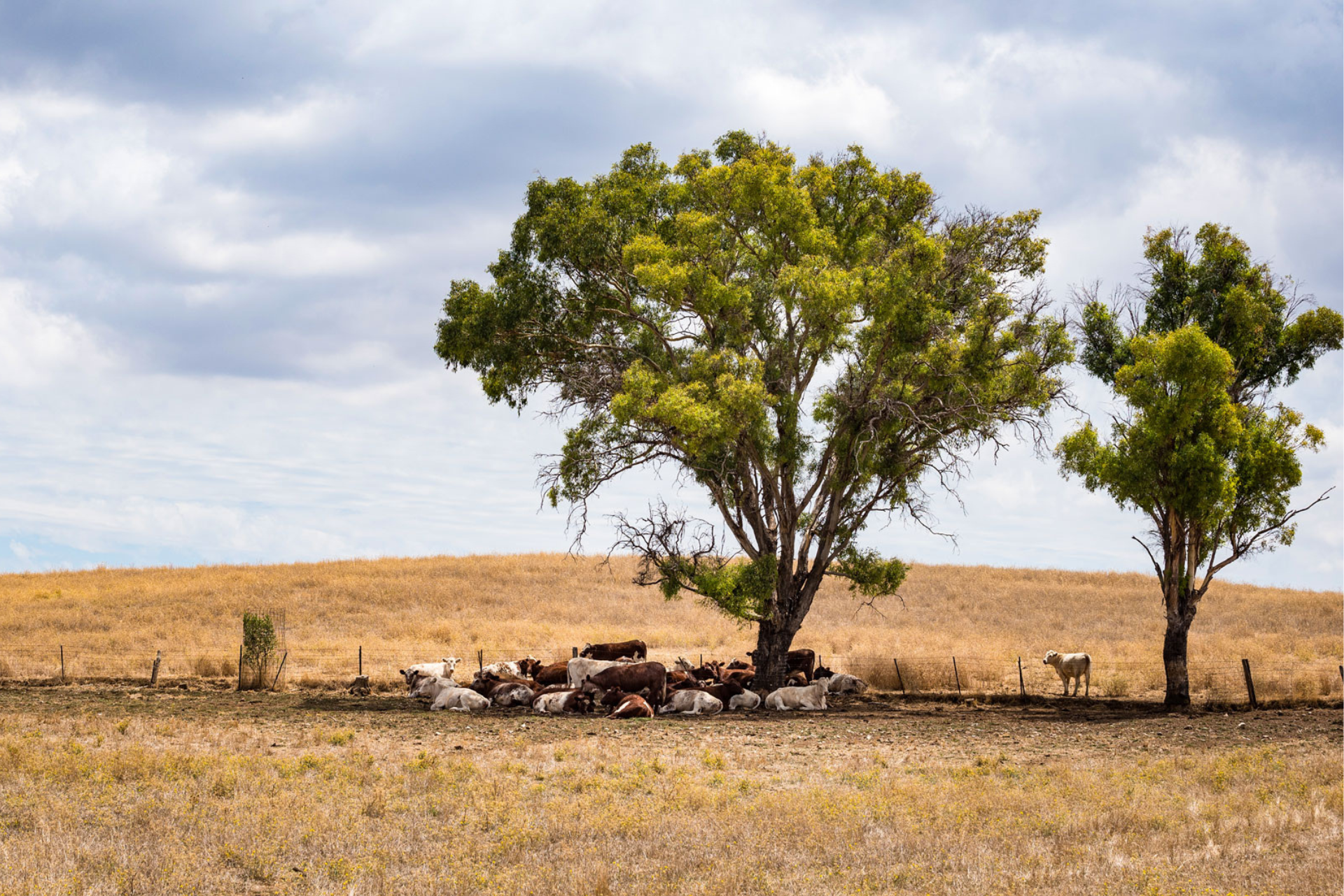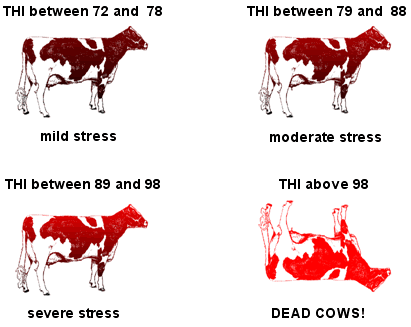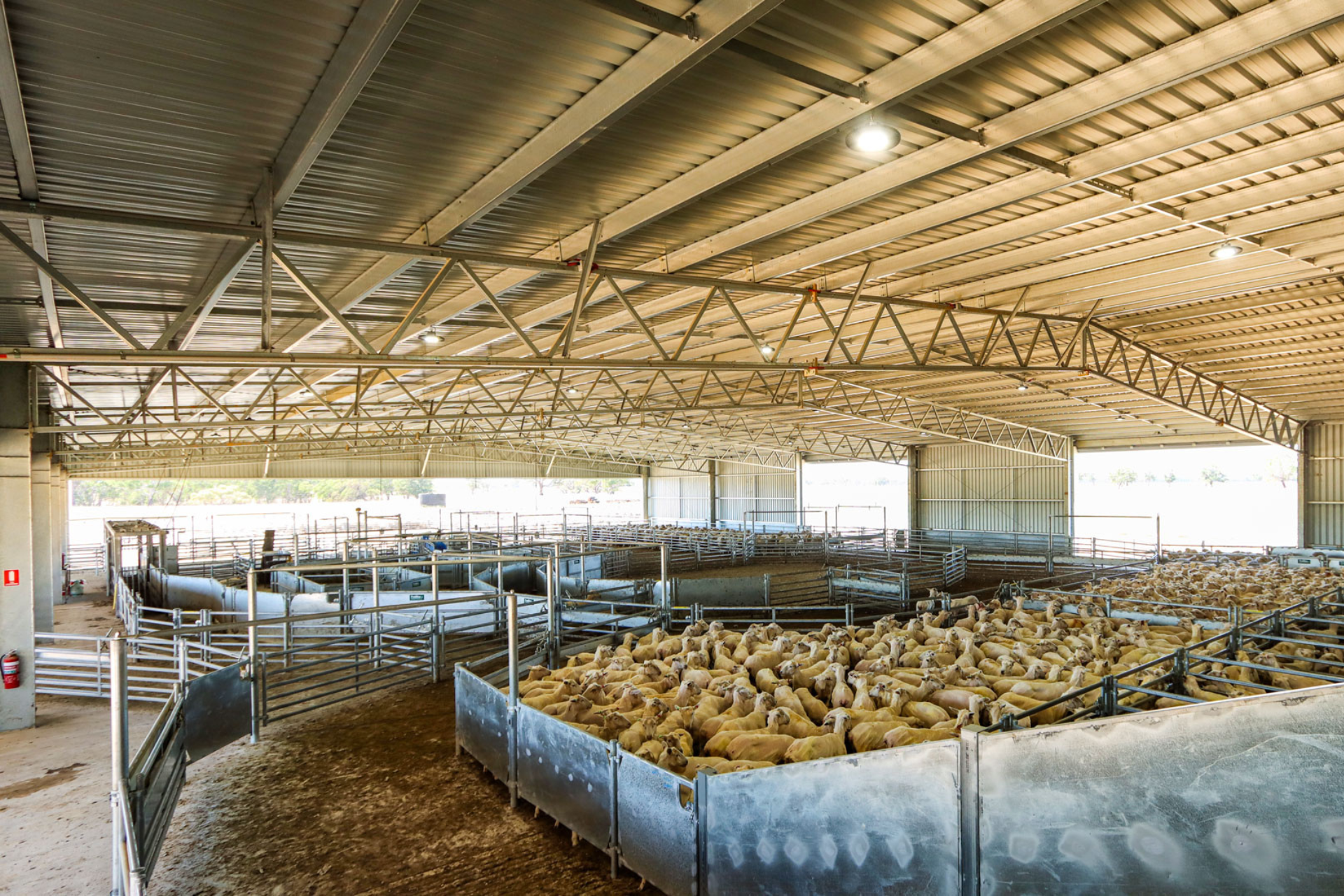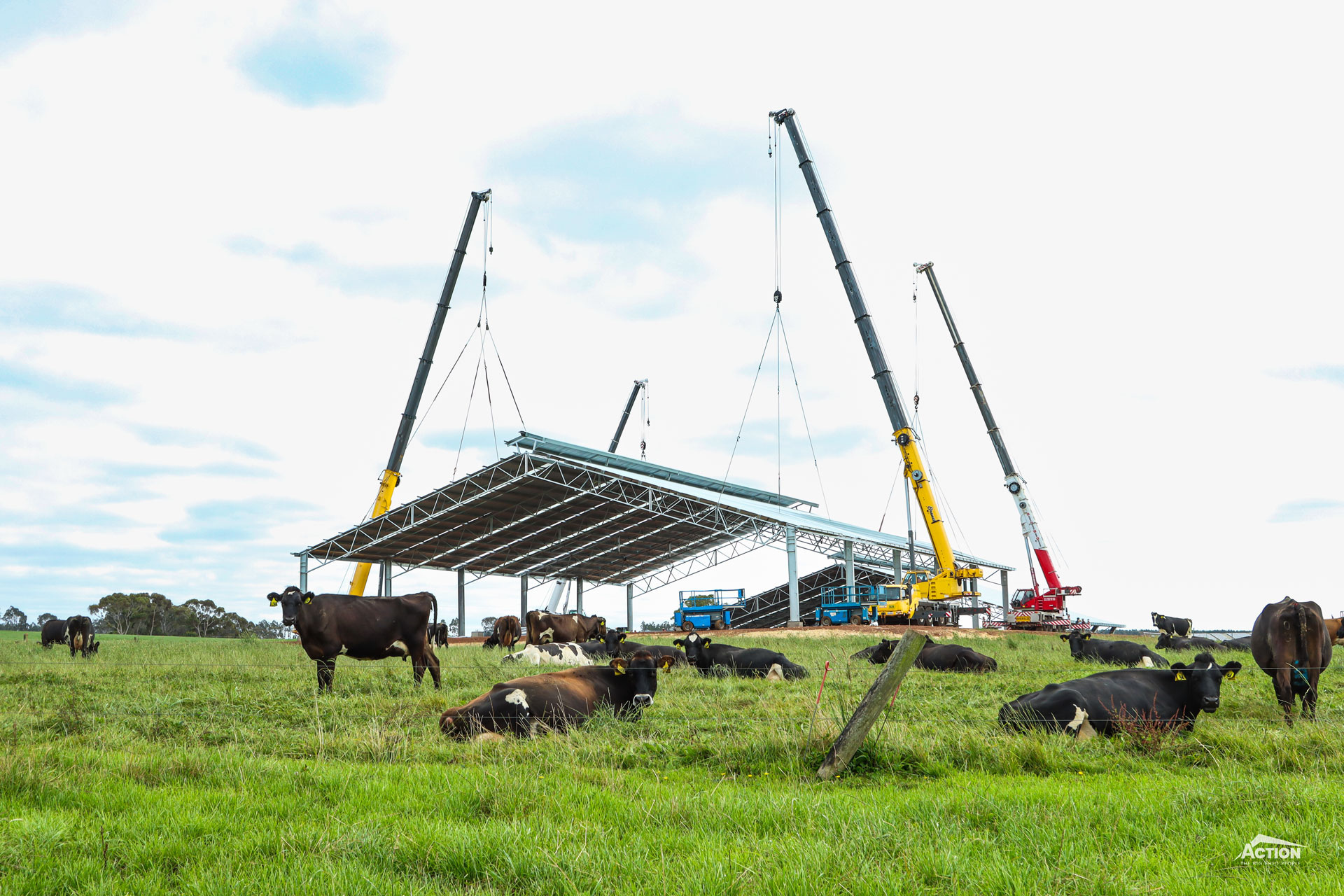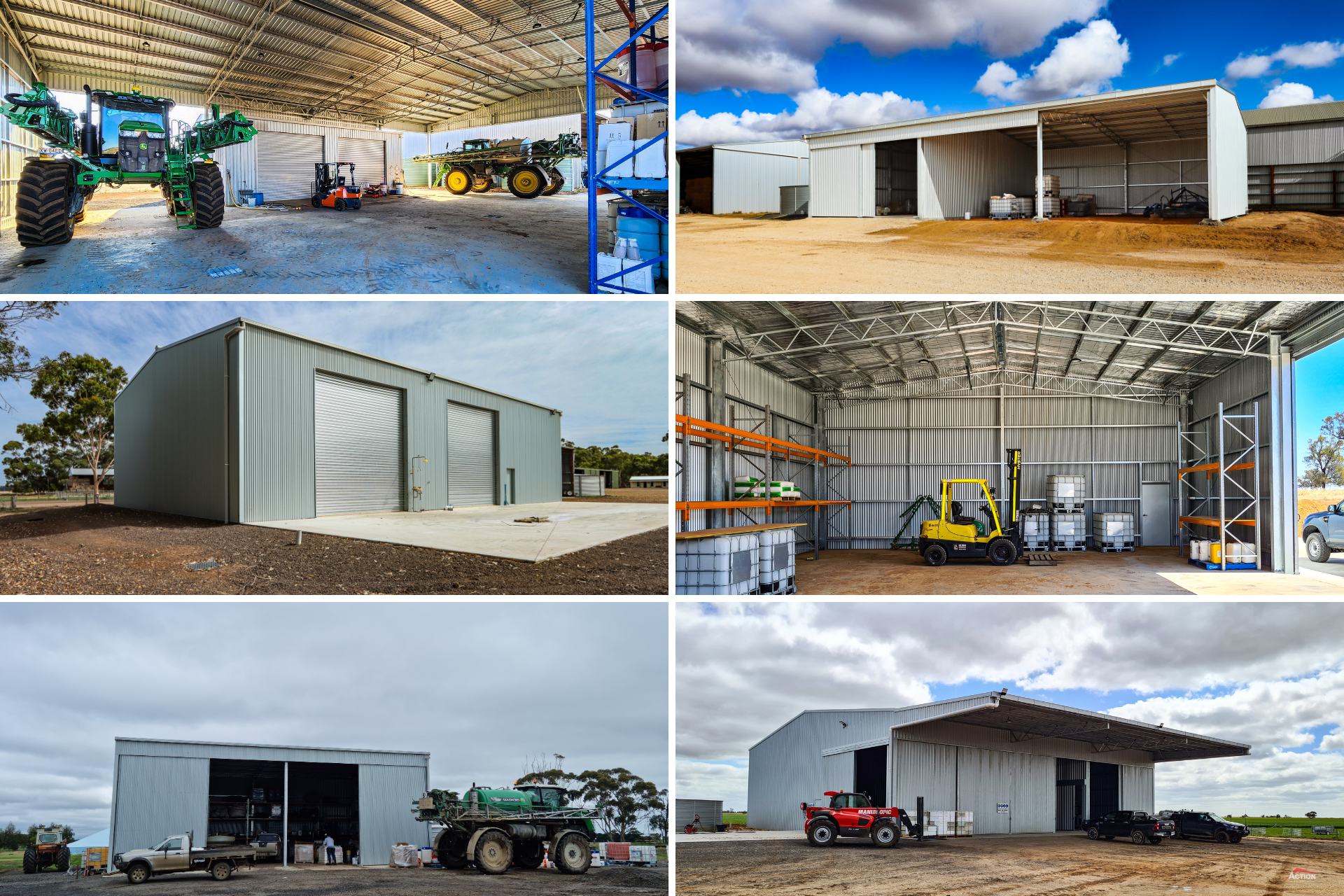There has been a recent renewed focus on the advantages of providing shelter and shade for cattle, driven in part by the Australian Lot Feeders’ Association new shade initiative.
The increased awareness of animal welfare by the general public and the correlation between animal comfort and productivity, have also encouraged greater interest and research into the topic of shade and shelter.
There are a number of really good reasons for providing shade for cattle, with arguably the number one reason being to improve animal welfare and animal comfort.
Providing shade for cattle is a timely and topical subject, and in this article, we’ll address some of the key points to consider when providing shade for cattle.
In this article
Do Cattle Need Shade?
What Is Heat Stress?
What To Do About Heat Stress
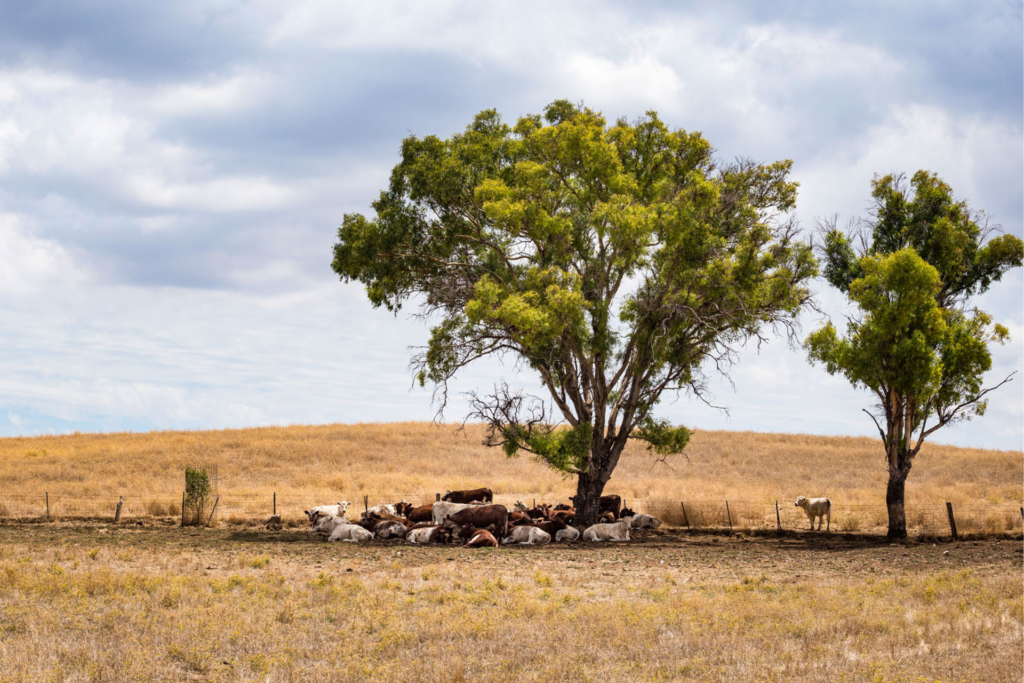
Do Cattle Need Shade?
The shade requirements for cattle will vary between cattle breeds, beef cattle, dairy cattle and geographical location, for example, cattle in an arid climate are at less risk of heat stress, particularly if it cools down at night.
However, cattle need shade and shelter to help cope with weather extremes and prevent cold stress or heat stress. While healthy cattle can tolerate a wide range of temperatures if they are acclimatised and have sufficient feed and water, weather extremes or extended periods of hot or cold weather without relief can be detrimental.
Some cattle will be more vulnerable to weather extremes than others, too, for example calves and cattle with a history or respiratory illness.
It is also important to remember that Section 9 of the Prevention of Cruelty to Animals Act 1986, requires the owner or the person in charge of the animal is required to provide the animal with proper and sufficient food, drink and shelter.
Providing shelter not only improves animal comfort, effective shade and shelter also means that the cattle will expend less energy on surviving, and more energy on thriving, improving productivity and performance.
Cattle become heat stressed once their Temperature-Humidity Index (THI) gets above 72.
An increase in THI is generally caused by a combination of high temperatures and high humidity and is influenced by factors like hot weather after rain and high overnight temperatures. Air flow and sunlight also contribute to heat stress, particularly in a feedlot situation.
Identifying Heat Stress
Recognising the signs of heat and cold stress and understanding the effect on your cattle helps recognise the importance of providing shade for cattle, to minimise the impact.
An easy method to determine if cattle are heat stressed is to observe their respiration rate and panting. Cattle can’t effectively cool themselves via perspiration because they have fewer sweat glands compared to animals like horses, so they increase their respiration rate.
A respiration rate of below 40 breaths/minute generally indicates that the animal has a safe and healthy body temperature. A rate of 80 breath/minute or higher indicates heat stress. Open mouth breathing, an extended tongue and drooling indicate a higher respiration rate (for example 110 – 160 breaths/minute) and are sure signs of heat stress.
According to USDA’s Agricultural Research Service, there are six stages of heat stress:
- Stage 1 is an elevated breathing rate, and cattle are restless, spending increased time standing.
- Stage 2 is an elevated breathing rate with slight drooling, and mot cattle standing and restless.
- Stage 3 is an elevated breathing rate with excessive drooling or foaming. By this stage most animals are standing, restless and starting to group together.
- Stage 4 is an elevated breathing rate with open mouth breathing and possible drooling. By this stage most animals are standing, restless and starting to group together.
- Stage 5 is an elevated breathing rate with pushing from the flanks and open mouth breathing with a protruding tongue and possible drooling. Most cattle are standing and restless.
- Stage 6 is open mouth breathing with a protruding tongue. Breathing is laboured with head down and pushing from the flanks – the respiration rate may decrease. Individual animals may be isolated from the herd.
The Effect of Heat Stress
Short term effects of heat stress are reduced feed intake, reduced daily gain, and in severe cases death.
As well as the immediate affects of heat stress on cattle, the College of Agriculture and Natural Resources at Michigan State University, points out that beef producers need to be aware of the long-term impacts and implications of heat stress such as lower conception rates and early embryonic death loss of the new fetus in the first few weeks after conception.
What To Do About Heat Stress
Early intervention and prevention are always better than cure, and for heat stress acting quickly can save heat stressed cattle from further suffering and death.
As soon as signs of heat stress are identified, take proactive action to minimise heat stress, such as controlling flies, providing adequate shelter and water, high quality food, sprinklers and adjusting feeding times.
Here are 10 tips for minimising heat stress.
1. Provide adequate, clean water
It is important to provide plenty of clean water for cattle in a heat event, or extended period of hot weather for a number of reasons:
- Heat stressed cattle have increased water intake requirements due to losing water via increased respiration rates and perspiration. Supplying high-moisture feeds like silage is another way to help meet the increased water requirements.
- Drinking water is the quickest way for cattle to reduce their core body temperature. It is a good idea to have shade for the water too as cool water helps to cool the cattle.
- Like shade, water is essential for minimising heat stress in cattle. As Dr Stephen Blezinger says; “If you compromise on these, you lose performance (less weight gain in calves, less milk production in cows) simply because the cattle won’t eat as much when they are hot and miserable.”
“Of the six classes of nutrients – carbohydrates, fat, protein, vitamins, minerals and water – water is most often overlooked, yet the most critical. Cattle performance can be affected by water intake.” – Rachel Endecott, Montana State University Extension Beef Cattle Specialist
Provide more than one water source to avoid crowding, or dominant animals preventing other cattle accessing the water.
2. Control flies
Controlling flies is another effective way to improve cattle comfort and minimise heat stress, particularly for feedlots as flies can cause cattle to bunch together and expend energy by having swat them away. To reduce fly numbers, apply insecticides and keep the feedlot cleaned out to minimise breeding areas for flies ahead of a heat event.
3. Use sprinklers
Sprinklers, if used properly, can also reduce the core temperature of heat stressed cattle as they increase evaporative cooling and reduce ground temperature. A few points to consider when using sprinklers are:
- Don’t run sprinklers continuously as this will increase mud in the feedlot.
- Ensure your water supply is adequate for both sprinklers and the increased water intake requirements during a heat event.
- Make sure cattle are used to sprinklers ahead of a heat event otherwise they may try to avoid them, which would be counterproductive.
- Place sprinklers away from feed and water troughs.
- To avoid increasing humidity, sprinklers should wet the cattle thoroughly rather than just misting the air.
- Use sprinklers before extreme heat stress occurs – using sprinklers too late can cause thermal shock and lead to death.
4. High quality feed and feeding times
Providing good quality feed and adjusting feeding times can also help combat heat stress as the metabolism and digestive process of cattle produce heat.
So how does high-quality feed help?
According to Tom Welsh from Texas A & M University Department of Animal Science, “High quality forages generate less heat during digestion than the fermentation of low-quality forages with more fibre. So, using high quality forages can be a way to put less heat load on the animal.”
Adjusting feeding times to take into account when the peak heat production from digestion occurs, can save placing unnecessary heat load on the cattle. For example, feed cattle two – four hours after the peak ambient temperature so that heat generated from digestion peaks (this usually occurs 4 – 6 hours after feeding) during cooler temperatures.
Similarly, where possible work or move cattle at cooler times of the day and avoid exerting them or bunching them together.
5. Watch weather forecasts
Keeping abreast of weather forecasts including high temperatures and humidity levels helps you identify when heat events will occur and allow you to prepare to combat heat stress.
6. Understanding Temperature-Humidity Index, heat load and heat tolerance
Understanding Temperature-Humidity Index, heat load and heat tolerance is key to minimising heat stress
As we have already discussed heat stress occurs when a cattle’s Temperature-Humidity Index gets above a certain point, but what exactly is Temperature-Humidity Index?
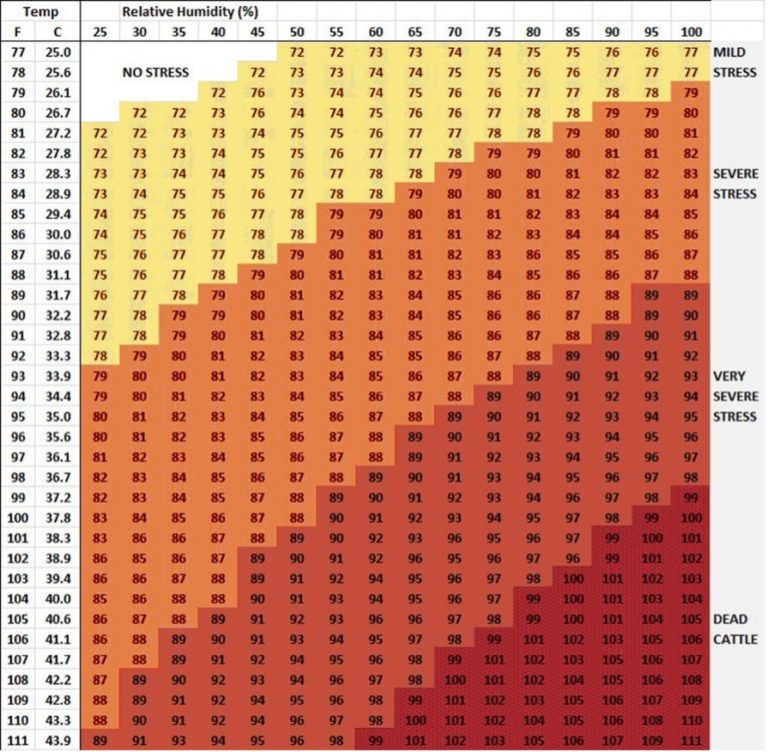
Source: From Veterinary Handbook for Cattle, Sheep, and Goats by The Australian Livestock Export Corporation (LiveCorp) and Meat and Livestock Australia (MLA), http://www.veterinaryhandbook.com.au
Copyright 2021 by LiveCorp
Heat load is an important consideration when the combination of high day and night temperatures prevents cattle from properly cooling. If the night-time temperatures in a heat event don’t drop below 21°C, and the cattle are unable to dissipate heat at night. As a result, the cattle’s core body temperature will continue to rise and if the heat event lasts for several days, this could potentially be fatal.
Heat tolerance varies between cattle breeds, body condition and colours. For example,
Brahman cattle have more sweat glands and therefore higher heat tolerance that British or European breeds, black cattle will absorb more heat from the sun than red or light-coloured cattle, breeds with thicker coats will get hotter that cattle with thin hair coats, fatter cattle will have more difficulty reducing their core body temperature and baby calves may be at a risk of dehydration especially if they are sick with scours.
7. Observe behaviour
Being aware of the signs of heat stress and observing cattle behaviour helps identify any potential issues and act before the problems escalates.
8. Ventilation
The importance of ventilation and airflow in shade and shelter should not be underestimated. Adequate airflow through a feedlot cover or loafing barn helps reduce the heat load on cattle and reduces the energy the cattle spend on physiological behaviour such as panting to reduce their core body temperature.
Ventilation options include fans, ridge vents and choosing the right orientation and location for your structure.
9. Mineral supplements
Providing mineral supplements such as a salt lick helps cattle replace the salt lost through sweating in hot weather. Talk to an animal nutritionist to ensure the salt content is adequate and discuss whether trace minerals such as zinc or copper are also required.
10. Shade
Shade is essential during hot weather to lower the body temperature and breathing rate of cattle – particularly for vulnerable or low heat tolerant cattle. Options for shade could include natural shelter such as trees, semi-permanent options like shade cloth or more permanent structures such as well-ventilated feedlot covers and yard covers.
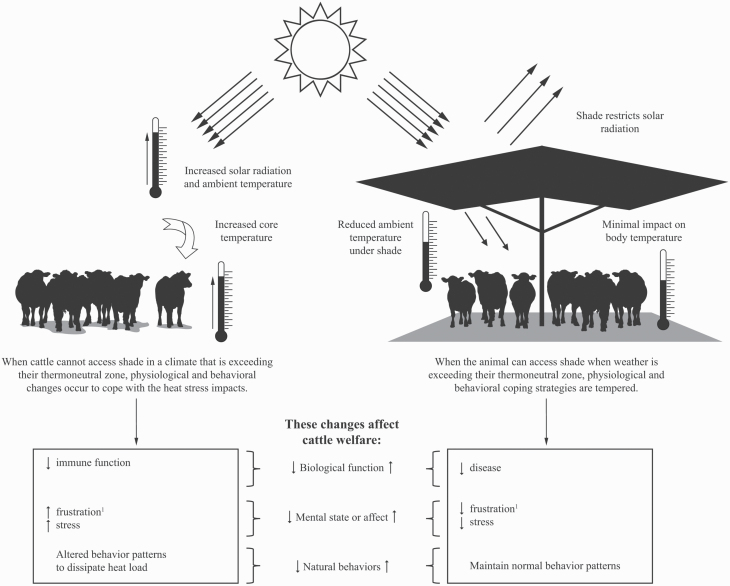
Source: Journal of Animal Science
Here are a few considerations to keep in mind when providing shade for cattle:
- According to MLA, a “north-south orientation of the shade is important – especially with longitudinal design – as this will maximise the amount of shade throughout the day.”
- Allow adequate room to avoid crowding, for example, Dairy NZ recommend allowing 5m² per animal.
- Common heights for cattle yard covers or feedlot covers are between four and five metres (MLA recommend at least five metres) high. These heights allow sufficient air flow and movement through the structure and also provides enough clearance for machinery such as a tractor for cleaning out the flooring.
- Other ways to improve airflow and ventilation are, ridge vents, fans and positioning the structure away from other large buildings so that airflow isn’t obstructed. Choosing the correct roof pitch is also important as a lower roof pitch equals slower air movement.
- Design is important in the planning stage of a new shade structure as it will influence return-on-investment and how long the infrastructure will last, and vice versa – poorly designed shade may not provide any benefits and may end up costing you money.
- Installing lighting in your shade structure means the facility can be used day and night, allowing work to be conduct in the lower night temperatures. This also lengthen feeding times and increase feed consumption.
- Not only does shade keep cattle cool, calm and content it also keeps feed dry reducing feed wastage, and bedding and flooring materials last longer.
- Shade can improve final carcass quality: “If you’re trying to gain every bit of high-quality beef that you can, then you probably need to think about adding in some shade and protecting the cattle when there is some sort of an environmental anomaly.” – Daniel Clark, Certified Angus Beef.
- Your staff also benefit from shade structures with improved working conditions. Taking into consideration people comfort is essential for retaining staff and attracting new staff.
Featured Project: Jalna Feedlot
ALFA recently spoke with David Gillett about his 224-metre-long feedlot cover built by Action Steel in 2017.
The topic of shade for cattle is an extensive one, and this article really only provides a brief overview on heat stress, the importance of shade and design considerations.
Browse our Learning Hub for articles and farm shed resources. Or, talk to one of our building consultants for project ideas for feedlot covers, loafing barns and yard covers.

